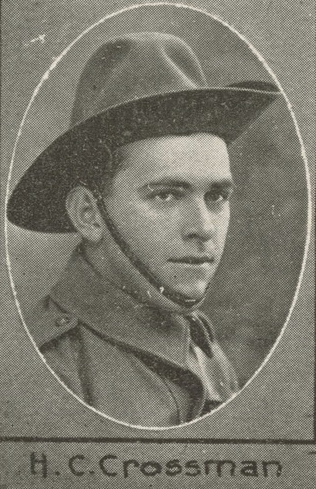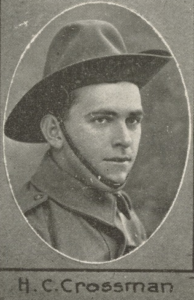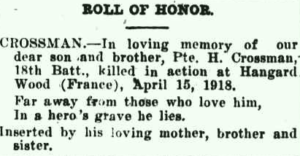In the early hours of 15 April 1918 Harold Charles Crossman became the unfortunate victim of friendly fire at Hangard Wood on the Western Front. Harold and three other soldiers of the 18th Battalion, B Company were digging in a machine gun post in no man’s land in front of the allied line in preparation for an advance.
Eyewitness Private Sydney Percival Cox disclosed:
I was on an outpost at Villers-Bretonneux at about 1am on 15 April 1918 and our machine gun accidently killed him. He was sent with a party to dig in our flank and we mistook them for the Germans. He was brought in and buried. He had been killed by a bullet in the stomach.
Harold Charles Crossman was born in Orange in 1888, the second of four children of Charles Crossman and his wife Teresa nee Gleeson. Shortly after Harold’s birth the family moved to Lithgow where Charles, a baker by trade, worked as a miner.
Harold was educated at Lithgow Public School. As a young man he joined the Eskbank Ironworks as a boilermaker. It was around this time that he also became known by the nickname “Peter”, or “Pete”.
In 1910 Harold married Florence Reilly in Bathurst. A daughter, Dulcie Agnes, was born the following year.
In August 1916 Harold renounced his position at the ironworks to enlist in WWI. In early January about twenty of Harold’s co-workers attended a farewell at the Fewins’ Refreshment Rooms in Lithgow. “Peter” was presented with an initialled gold watch and speeches and songs were enjoyed.
Private Crossman embarked from Sydney on 20 January 1916; he disembarked in Alexandria on 26 February. In March he joined the British Expeditionary Force and proceeded to Marseilles. In late July Harold was wounded in action, receiving several gunshot wounds to the right shoulder and scalp. He was transferred to Tunbridge Wells Hospital in England and did not rejoin his unit until late November 1916.
In May 1917 he was wounded a second time and was admitted to the 2nd Australian General Hospital in Boulogne. Again he was transferred to England, this time to Tankerton Hospital in Whitstable. He rejoined the 18th Battalion in France on 15 October 1917.
Following her husband’s death Florence was granted a widow’s pension of £2 per fortnight; her daughter Dulcie, £1. Florence remarried in 1920.
Harold’s father Charles died in Lithgow in September 1918, a victim of the Spanish influenza.
Harold Charles Crossman is commemorated on Lithgow’s Fallen Heroes memorial in Queen Elizabeth Park in Lithgow, on his father’s grave in Lithgow Cemetery and on panel number 85 on the Roll of Honour at the Australian War Memorial in Canberra.



